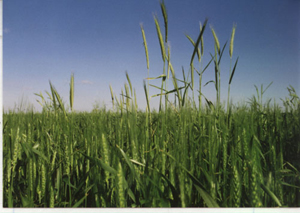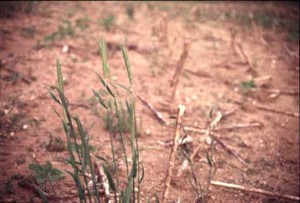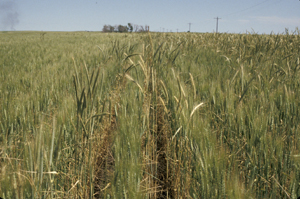G1483
Rye Control in Winter Wheat
Feral rye, also known as volunteer rye, is a winter annual grass weed that reduces wheat yield, grain quality and grade. Control methods are discussed in this NebGuide.
Drew J. Lyon, Extension Dryland Cropping Systems Specialist
Robert N. Klein, Extension Cropping Systems Specialist
- Controlling Feral Rye
- Feral Rye Control with Crop Rotations
- Cultural Methods for Feral Rye Control in Winter Wheat-Fallow Rotations
- Burning or Plowing to Control Feral Rye
- Herbicides for Selective Control of Rye in Winter Wheat
- Hand Roguing
- Acknowledgment
Feral rye (Secale cereale L.), also known as volunteer rye, has become a troublesome weed in winter wheat production in western Nebraska. Rye is grown in the state as a cover or pasture crop. It is also being used in wildlife and soil conservation seed mixtures. It is thought that our current rye problems in winter wheat originated when rye plants used for these other purposes escaped into cultivated fields. Since then, the rye plants with the most weedy characteristics (for example, longer seed dormancy) have thrived in continuous winter wheat and winter wheat-fallow rotations (Figure 1).
Feral rye causes problems because it typically matures and shatters before wheat harvest. The presence of feral rye in wheat grain may result in dockage, grade reduction and a loss of wheat quality. Millers and bakers avoid buying wheat contaminated with rye because the resulting flour has poor baking characteristics. Due to these concerns, winter wheat growers who continue to ignore their feral rye problems are sure to take notice at harvest with decreased payments or possible rejection of the grain at the elevator.
 |
 |
| Figure 1. Feral rye is an increasing problem in the winter wheat-fallow production region of western Nebraska. | Figure 2. The rye seed head (left) is slender, longer and somewhat nodding as compared to the winter wheat seed head (right). |
Feral rye and winter wheat are both winter annual grasses that reproduce by seed. Rye resembles wheat in habit, but may be differentiated from wheat by several characteristics (Table I).
| Table I. Characteristics differentiating winter wheat from rye. | ||
| Characteristic | Wheat | Rye |
| Stems | Erect and freely branching at base, 24 to 40 inches tall. | Larger and longer than wheat. |
| Leaves | Blade 0.4 to 0.8 inches wide, usually dark green in color. | Coarser and more bluish than wheat. |
| Ligules | Membranous with an irregular edge fringed with minute hairs. | Membranous, short and somewhat rounded. |
| Auricles | Purple changing to white, sharply curved and always present. | White, narrow, and withers early. |
| Seed head (Figure 2) |
From 2 to 5 inches long, oblong or elliptical in shape. | Slender, longer than wheat, and somewhat nodding. |
| Seed | Roughly egg-shaped and light brown to darker red. | Narrower than wheat and usually brownish-olive to yellow in color. |
In eastern Oregon, feral rye populations of 18 plants per square foot reduced winter wheat yield by 33 percent when removed in February and 69 percent when allowed to remain until harvest in July. In northeastern Colorado, winter wheat yields were reduced by 14 percent with feral rye populations as low as five plants per square foot. A single rye plant growing in a winter wheat field may produce nearly 800 seeds, allowing even a small infestation to dramatically increase.
Research on the longevity of rye seed in the soil found less than 20 percent of feral rye seed still alive one year after deposition into the soil, with less than 5 percent viable after two years. However, farmer experience suggests that rye seed may lay dormant for five to 10 years or more. Rye seed has more seed dormancy and longevity than downy brome, but not as much as jointed goatgrass. Feral rye also may be introduced by planting contaminated seed or by not cleaning the combine between fields. Rye seed is also readily moved by water. Intense rainstorms (“gully washers”) are believed to move rye seed out of borrow ditches and infested fields into previously uninfested fields downstream.
Controlling Feral Rye
Preventative methods are a critical part of an integrated weed management control system for feral rye. Eliminating potential seed sources for rye establishment is a top priority.
|
To eliminate seed sources:
- Plant clean seed. Feral rye seed is often found in small grain seed, especially winter wheat. It is difficult to separate feral rye seed from winter wheat seed, therefore growers should be knowledgeable about their winter wheat seed source or buy only certified seed.
- On cultivated fields, destroy any feral rye before it produces seed. Rye may germinate as late as mid-April and still have sufficient cold weather to vernalize and produce seed. Rye plants as short as 6 inches can produce viable seed (Figure 3).
- Thoroughly clean combines before moving between fields.
- Make sure that all rye is kept out of roadside ditches and other areas that may contaminate the fields. This task may be aided by covering all trucks transporting winter wheat grain.
Feral Rye Control with Crop Rotations
Feral rye is best controlled in winter wheat rotations that include late spring-planted crops such as corn, grain sorghum, sunflower, or proso millet. Table II shows the weed densities for feral rye in various rotations. Early spring-planted crops such as spring wheat, oat or spring barley still provide the opportunity for some volunteer rye to germinate, vernalize and produce seed.
| Table II. Feral rye density in winter wheat in two- and three-year crop rotations at Sidney, Nebraska. | ||
Rotation |
After one rotational cycle |
After two rotational cycles |
-------- No. of plants/yd2 ---------- |
||
| WW-Fallow with fall tillage WW-Fallow with fall atrazine WW-Fallow-Fallow WW-Sunflower-Fallow WW-Proso millet-Fallow |
2.2 3.7 0.1 0.2 0.1 |
1.0 3.9 0.01 0.04 0.02 |
| WW = winter wheat | ||
If a crop rotation is planned with late spring-planted crops following winter wheat, feral rye usually will not be a problem unless it is not controlled prior to planting the late spring-planted crop and/or during the following fallow period.
With late spring-planted crops, tillage and/or herbicides can be used to control feral rye before planting. For this to work effectively, crop residues, both long straw and fines (chaff), must be distributed evenly. Also, with corn or grain sorghum, higher rates of atrazine can be used the previous fall after winter wheat harvest. This is effective in reducing feral rye populations. Corn and grain sorghum yields have been better when the crop is planted no-till into the winter wheat stubble treated with atrazine after wheat harvest. Skip-row planting may improve the success growers have with rainfed corn in areas of low precipitation and shorter growing season. The disadvantage of no-till planting is that some of the feral rye seed will not have sufficient contact with the soil to germinate. This seed, when later placed in contact with the soil, germinates and can be a problem even in rotations with spring seeded crops.
Sunflower and proso millet are very effective rotational crops for controlling feral rye populations, especially if tillage is used for seedbed preparation. The disadvantage of tillage is that crop residue is destroyed and soil moisture is lost. Maintaining crop residue through the high wind months of March, April and May is important in reducing soil loss and also may be required by conservation compliance programs. Some growers use herbicides early to control weeds and retain crop residues and then switch to tillage later to prepare the seedbed and cultivate for weed control in sunflower. Check with the proper agencies to make sure you meet program requirements.
Remember, in these crop rotations it is very important to kill feral rye with herbicides or tillage before planting the spring-seeded crop.
Cultural Methods for Feral Rye Controlin Winter Wheat-Fallow Rotations
For some western Nebraska winter wheat growers, crop rotation is not an attractive option. Therefore, they must improve control of feral rye during the fallow period. When selecting a treatment, consider soil erosion from wind and water, equipment availability, and the farm program.
Good weed management programs require seed to germinate during the fallow period. Germination requires good seed-to-soil contact. Therefore, crop residue distribution is very important. Straw choppers on combines with straw walkers help spread the straw and make it easier to get good seed-soil contact later. Rotary combines break up the straw and hence choppers are not usually needed. It is very important to spread the fines or chaff. Feral rye will be spread with the fines, allowing for good seed-to-soil contact with subsequent tillage. After trying to eliminate all possible seed sources, the next step to controlling feral rye is to provide even distribution of the crop residue.
After the crop residues have been adequately distributed, several other cultural practices may help control feral rye in a winter wheat-fallow rotation.
- Sweep tillage or light disking immediately after harvest will plant the feral rye for optimum germination. Sweep tillage needs to be done within seven to 10 days after harvest before the ground dries.
- Use sweep tillage or light disking again in late August or early September and apply atrazine. This tillage operation kills emerged feral rye and wheat while the atrazine controls new flushes. Be sure to match atrazine rates with soil types. Atrazine use may not be appropriate for some high pH, low organic matter soils in western Nebraska, especially in a winter wheat-fallow rotation.
- Use tillage twice in April or apply glyphosate before feral rye heads. Herbicides are more effective than tillage in moist spring soils and do not destroy additional residue. For tillage to work well, the soil must be dry and air temperatures must be warm enough to desiccate plants within 30 minutes.
- Sweep or rodweed during the summer, using tillage as needed to control weeds and prepare seedbed.
- Delay planting if wind erosion is not a big problem for the soil type and terrain. If a timely rain occurs, germinating feral rye can be eliminated with herbicides or tillage before the winter wheat is planted.
Burning or Plowing to Control Feral Rye
Burning frequently results in soil erosion. Also, fire is usually not hot enough to kill a high percentage of feral rye seed. The amount of crop residue, the temperature, and the length of burn greatly limit fire as a potential weed control method.
Plowing at least 6 inches deep will bury much of the seed and control as much as 90 percent of the feral rye. Plowing is probably not as effective for rye as it is for downy brome because rye emerges better than downy brome when buried 2 to 6 inches deep. Also, the longevity of rye seed viability increases as burial depth increases. To prevent bringing previously buried seed back to the soil surface, do not plow every fallow period. Plowing leaves little crop residue on the soil surface, making the soil subject to erosion.
Herbicides for Selective Control of Rye in Winter Wheat
The Clearfield® production system was introduced in fall 2002. This program combines the use of Beyond® herbicide with a winter wheat cultivar containing the gene that confers tolerance, not resistance, to this herbicide. Wheat cultivars that contain this gene may be treated with Beyond® herbicide with minimal risk of injury to the crop. Winter wheat cultivars that do not contain the tolerance gene are seriously injured or killed when treated with this herbicide.In field studies conducted in western Nebraska and throughout the western winter wheat belt, the Clearfield® production system provided excellent control of jointed goatgrass and downy brome when weeds were treated with 4 ounces of product per acre in the fall or early spring. Postemergence applications of Beyond® require adding an adjuvant and nitrogen fertilizer solution. Good control of feral rye required an early fall application with 5 ounces of product per acre. Optimum control of feral rye was achieved when the application was made before rye plants had produced a tiller. To prevent wheat injury, wheat plants had to have at least three leaves emerged. No previous technology has provided this level of selective control of feral rye in winter wheat. However, grower experience with Beyond® for feral rye control has been inconsistent. Some growers have been very pleased, some have been very disappointed, and others have both experiences. As a result of these grower experiences, the Beyond® label now claims only suppression of feral rye. Until we have a better understanding of what is causing the inconsistent results, growers are advised to use conservative estimates for feral rye control when deciding whether or not to use the Clearfield® system in their operation.
As with most technology, there are some concerns with using the Clearfield® system. One concern is the development of herbicide-resistant weeds. Beyond® belongs to a class of herbicides known as ALS-inhibitors. Other herbicides in this class, such as Glean® and Pursuit®, have a history of quickly selecting for resistance in weed populations. Examples include ALS-resistant Russian thistle, kochia, prickly lettuce and pigweed species. Without adequate safeguards, it is likely that weeds resistant to Beyond® will be common in just a few years.
In order to delay the onset of herbicide resistance, fields treated with Beyond® should not be treated with another ALS-inhibitor such as Ally® or Peak®. If additional weed control is needed, for example to control warm season broadleaf weeds like kochia or pigweed species, herbicides with a different mode-of-action should be used. Herbicides containing 2,4-D or dicamba would be good choices for additional weed control.
|
The Clearfield® stewardship program for wheat requires the use of certified seed. Growers are not allowed to save back any grain for seed. Growers should not use the Clearfield® system for wheat more than twice every six years. This allows the system to be used every time that winter wheat is grown in a three-year rotation containing a late-spring seeded crop and summer fallow. Growers in a winter wheat-fallow rotation are advised not to use the system in more than two consecutive wheat crops, or weed resistance may rapidly develop.
Another option for controlling rye in winter wheat is to apply glyphosate with a ropewick applicator. The rye should be 10 to 12 inches taller than the wheat for best results (Figure 4). In heavy stands of rye, travel in both directions. Remember that if you contact the wheat with the rope-wick or drip the herbicide on the crop it will cause injury. Glyphosate should be mixed at a 33 percent concentration or 1 gallon of herbicide with 2 gallons of water. Surfactants may be needed for some glyphosate formulations.
Hand Roguing
For small infestations prevent seed production by pulling or breaking off the plants at ground level shortly after heading. Once plants reach the soft dough stage in development, the seed becomes viable. Any roguing would need to be done before the plants reach this stage.
Acknowledgment
We acknowledge the contributions to this publication by Gail Wicks, former weed scientist at the West Central Research and Extension Center, North Platte.
| Reference to commercial products or trade names is made with the understanding that no discrimination is intended of those not mentioned and no endorsement by University of Nebraska–Lincoln Extension is implied for those mentioned. |
Visit the University of Nebraska–Lincoln Extension Publications Web site for more publications.
Index: Weeds
Field and Pasture
2002, Revised May 2007

